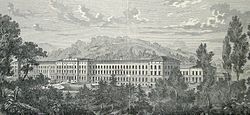Analytical psychology
Analytical psychology is the school of psychology that came from the ideas of Swiss psychiatrist Carl Jung. Analytical psychology has two main parts:
- The first part is clinical and related to the care of any particular person (child or adult), who suffers from mental health issues such as addictions, anxiety, depression, panic attacks and fears, using talking and sometimes drawing, painting, music or sand-play.
- The second part is about research into all kinds of repeating patterns in the human mind and in human behaviour. They include the contents of dreams, personality types like introversion and extraversion, being shy or a show off, feeling abilities and sensations. The research is guided by clinical theories, observations and experiments like active imagination, free-association of ideas and word association tests. It also includes looking into the meaning of fairy tales, myths and legends as well as paranormal events and coincidences.
+{{{1}}}−{{{2}}}
Analytical Psychology Media
Still talking, Jung with psychoanalytic colleagues. Front row, Sigmund Freud, G. Stanley Hall, Carl Jung. Back row, Abraham Brill, Ernest Jones, Sándor Ferenczi. 1909 in front of Clark University.
Psychology of the Unconscious (1916), the book which precipitated Jung's break with Freud
American philosopher of pragmatism William James greatly influenced C. G. Jung's thinking.
Wilhelm Wundt and associates in 1880
Dream Analysis, 1928–1930 seminars given by Jung, first published in English in 1984
Persona is a social representation of the self, drawn from the Latin term for "mask". It serves as a public face.
A rose chafer, the type of beetle Jung caught in his hand, as he heard a patient's dream containing a golden scarab








